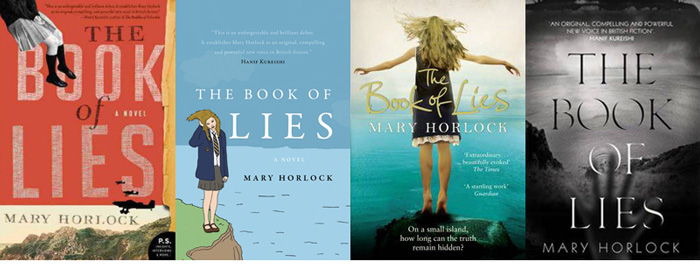

This terrific debut novel merges a tragicomic teen drama set on 1980s Guernsey, with the German occupation of the island during World War II. Author Mary Horlock alternates the two narratives, which share phrases, motifs, and—most important—events. Although they are completely different, and each has its own distinctive voice, the stories slyly echo each other, resulting in a novel that is both clever and unusual. The Book of Lies shows what can happen when the past casts shadows onto the future, and what happens when history is written, revised and rewritten. It is at times sinister and dark, and at other times very funny.
The main narrative follows fifteen-year-old Catherine Rozier, sometimes called Cat, and her first-person rantings about her life as someone who is "under popular and overweight." On the first page of the book, Cat confesses to murdering her so-called "best friend," Nicolette. However, it is soon clear that she is prone to sensationalism and theatrics, and her credibility as a narrator is dubious. She admits that "sometimes you have to twist the truth to make it interesting," and boasts "it's true I have a brilliant imagination (which explains my high grades in Creative Writing)."
Cat is what my own fifteen-year-old daughter and her friends would label as "socially awkward." Her lack of people skills leads her to misread situations and people, and this drives much of the tension in her storyline. Cat is, somewhat puzzlingly, befriended by Nic, the gorgeous new girl at school. From the beginning, both the reader and Cat know that no good will come of this, as she says "teenage girls are trés mega horrible, and Nic was exactly like that but prettier." Unfortunately, she can't resist any chance of friendship, and gets caught up in events. Things get nasty, of course, and Cat observes, "on an island this small, your friends and enemies quickly end up the same." Horlock vividly captures an authentic teenage voice in this character. Cat expresses herself humorously, and her cheeky, but sometimes naïve, comments are often loaded with unintentional meaning.
Cat is also troubled by the death of her father, a local historian, the year before. Her father had made it his life's work to uncover and expose "The Whole Grim Truth" of what happened on Guernsey during the Second World War. This story, which is told through letters, articles, and mostly by her Uncle Charlie's testimony, makes up the second narrative thread in The Book of Lies. Uncle Charlie was a teenager during the war, and like Cat forty years later, he misread situations and chose the wrong friends. When he returned from a Nazi concentration camp at the end of the war, the islanders treated him not as a hero, but with disdain. This part of the novel is likely to appeal to fans of the bestselling Guernsey Literary and Potato Peel Pie Society. The different twist is Horlock's play with ideas of truth, memory, and perception. She looks at the "difficult legacy" of WWII Guernsey, and presents contradictory versions of the events from those involved. Based on other characters' reactions, we come to realize that Cat's dad is not the genius that she believes him to be. In fact, he's probably rather balmy.
Mary Horlock grew up on Guernsey, and her strong sense of place makes the island itself an important character in The Book of Lies. In describing her home, Cat says:
Within the narrative, there are strong currents of the difficult relationship between the island and Britain, fraught with mutual mistrust and disrespect. Cat constantly brings up trivia about the island's history to illustrate her current situation. Like teens who live in small towns everywhere, she is restless and frustrated, and takes disparaging shots at the island every chance she gets. The Nazis may have thought of it as a small paradise, but Cat retorts: "since when did a few manky palm trees make a paradise?" She often uses footnotes for tangential information and commentary, and this is where the reader will find much of the wit.
With its quirky protagonist and mean-girl storyline, some readers may misjudge The Book of Lies as just a young adult novel. I would caution potential readers against dismissing it as such; they would risk missing the beguiling complexity of this story.
The main, factual events of the novel are no mystery: Nic dies falling off a cliff, and Uncle Charlie goes to a concentration camp. It's how these events come to pass that kept me glued to the book. As Cat says,
In the end, it is up to the reader to decide what is true in this subtly sophisticated gem of a novel.
The Book of Lies is published by Harper Perennial (US), paperback, 9780062065094 (2011) and Canongate Books (UK), paperback, 9781847678867 (2012)

Joyce Nickel is a corporate writer from Vancouver, Canada. When she's not reading or traveling, she can be found enjoying the outdoor lifestyle of the Pacific Northwest.

Mary Horlock was born in Australia but grew up on Guernsey in the Channel Islands, moving to England at the age of eighteen. She studied at Cambridge and went on to work as a curator at Tate Britain and Tate Liverpool. She is a former curator of the Turner Prize. Mary lives in London with her partner and their children and is currently writing a book on art and camouflage in the Second World War. Although she has written widely on contemporary art, this is her first novel.